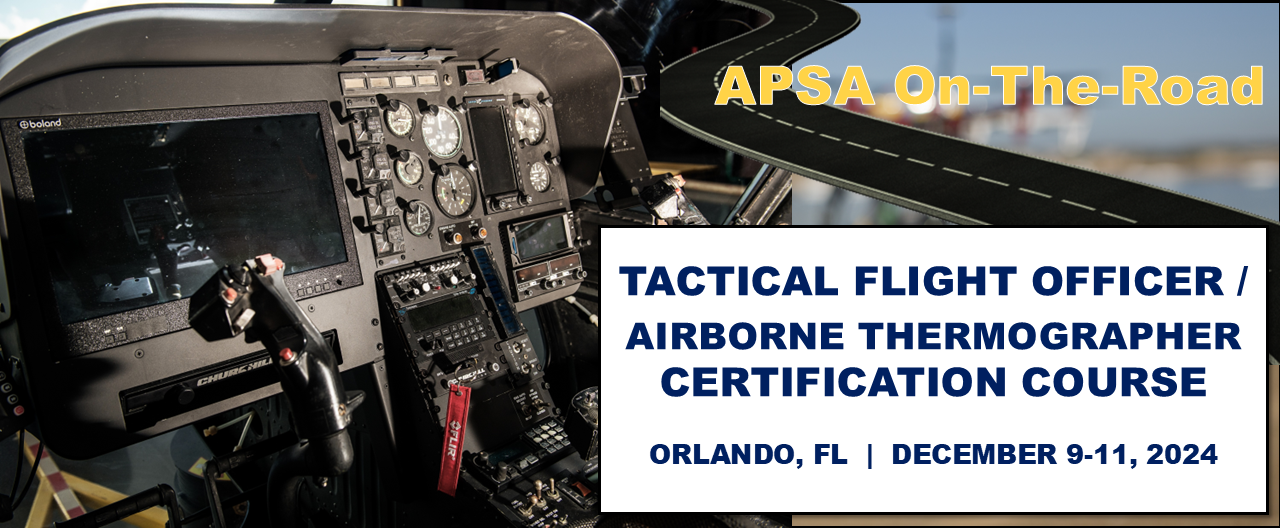| Welcome!
APSA's E-Newsletter is designed to help keep you informed on the very latest information in the airborne law enforcement industry. The E-Newsletter may also be read online here at our website. Three Rescue Officers Killed in Spain Helicopter Crash
The regional government in Spain said four more helicopters and an ambulance were deployed to the crash site following the incident. The victims, all members of Spain's rural Civil Guard Police, were identified as the pilot, co-pilot and winch operator. SOURCE: www.neurope.eu Flight Restriction Results When Ferguson Rioters Fire on St. Louis Chopper
The decision to request FAA's help in securing a flight restriction "was made immediately when our St. Louis County Police helicopter was fired at multiple times on Sunday night," St. Louis County Police Spokesman Brian Schellman said. The restriction allowed only relief operations conducted by the St. Louis County Police Department to access a 3-nautical-mile radius around the town. FAA spokesman Tony Molinaro said the agency issues flight restrictions to local law enforcement agencies that provide good reason for them. SOURCE: www.dailycaller.com Ferguson Incident Draws Negative Attention to Military Surplus Program
A spokesman for the Defense Logistics Agency confirmed the Ferguson Police Department has been part of the surplus equipment program. It reportedly has received two tactical vehicles, a generator and a trailer. On Aug. 27, President Barack Obama announced a review of federal programs that transfer surplus military equipment to state and local law enforcement agencies. The review will decide whether the programs are needed, if agencies are properly trained to work with the military grade equipment they receive, and whether the federal government is effectively keeping track of the equipment and their use. SOURCE: www.officer.com and www.homelandsecuritynewswire.com Final Two of Six UAS Test Sites Start Ops
"Having all six national test sites up and running will give us more and better data to help expand the safe use of unmanned aircraft into our airspace," FAA Administrator Michal Huerta said. The site at Griffiss International Airport in Rome is expected to use PrecisionHawk Lancaster UAS for agricultural research and monitoring. Flights of the three-pound, four-foot-wide drones will last less than an hour and take place below 400 feet. "We are accomplishing two important missions with the launch of this test site," Transportation Secretary Anthony Foxx said in a statement. "The safe integration of unmanned aircraft into the NAS is our number one priority, but the agricultural research performed in Rome also may have far-reaching benefits to farmers in New York and across the nation." SOURCE: www.rotor.org and www.thehill.com TopSend to a FriendNightCon's Mark of Excellence and Lifetime Achievement Awards Presented
For his contributions to the advancement of night vision in aviation, Kevin Means (pictured second from left above) received the Lifetime Achievement Award. A longtime APSA member and former president, Means flew with the San Diego Police Department Air Support Unit for 24 years and retired last year. "Night vision goggles were a critical component of our aviation unit's operation for many years," Means said. "As pilots and tactical flight officers, we depended on them nightly, not only for aviation safety, but for tactical effectiveness as well. They enable us to operate much safer and far more effectively than in previous years." SOURCE: Night Vision Awards Omaha Police Department Grounded, Returns to the Air
An examination revealed microbial growth inside the fuel tank; however, a simultaneous inspection of the department's other aircraft determined the fuel filters had prevented the spread of the contamination. Continued inspections showed the sludge was the result of a fuel boost pump problem. All aircraft were returned to service after the inspections were completed and airworthiness assured. The Omaha Police Department operates two Bell 206Bs and two OH-58s. It also has several military surplus airframes it uses for parts. SOURCE: www.aviationtoday.com
San Jose Police Adds UAS, Answers Allegations of Secrecy
The department bought the UAS using federal grant money for the stated purpose of aiding its bomb squad in assessing threats. The UAS reportedly will be available to 13 other bomb squads around the area, including law enforcement agencies in San Francisco and Oakland. San Jose Bomb Squad Sergeant Douglas Wedge said the UAS costs 95 percent less than bomb robots used for the same purpose. Though officials have said only the bomb squad will use the drone, the San Jose Police Department is still in the process of drafting its full policies for UAS use. Opposition to UAS use has been particularly fierce in California, where the Alameda County Sheriff's Office and San Mateo County Sheriff's Office have been prevented from acquiring the aircraft. The San Francisco Police Department's recent bid for a UAS also failed. SOURCE: www.sfgate.com Texas Man Accused of Pointing Laser at DPS Helicopter
The pilot and co-pilot were conducting routine operations when the "intensity of the light" impaired their control of the helicopter. Ground patrol responded to the residence where two men were seen standing. TXDPS then found a small flashlight, which emitted a green laser light, underneath a couch cushion. The man told authorities he was shining the laser on trees, but he was arrested and charged with illumination of aircraft by intense light, a Class A misdemeanor. The man was booked into the county jail on the charge. SOURCE: www.valleycentral.com Tulsa Police Receives New AS350
Before the latest aircraft delivery, the Air Support Unit utilized two Bell 206L4 LongRanger helicopters. The AS350 will replace the older of the two LongRangers. SOURCE: www.verticalmag.com
Dubai Jet Skier Rescued by Police Helicopter
The Abu Dhabi Police Air Wing was called to launch a search and rescue helicopter, but it was initially unable to take off due to low visibility. Eventually, the team was able to get airborne and used night vision goggles and a thermal imager to find the victim. The rider was rescued after 15 hours, which included two refueling stops for the air unit helicopter. After the rescue, the man was taken to a nearby hospital where his condition was described as fair. SOURCE: www.thenational.ae
Maryland State Police Takes Delivery of Final AW139
SOURCE: www.agustawestland.com
Spokane Sheriff Expanding Aviation Program
In addition to the two helicopters, the department received a spotlight from King County that is expected to allow the new aircraft to serve as an effective backup to Air 1. Spokane aviation officers have pointed to Air 1's capability during pursuits as one of the key selling points of the unit. The unit hopes to have the backup helicopter ready to fly by the end of September. SOURCE: www.kxly.com
LAPD's Concern for Hobby UAS Grows
mid-August, a California man who often films police activity flew his UAS over LAPD's Hollywood Division parking lot and recorded officers. The man said he was safely and legally standing on the public sidewalk, but police suggested they could arrest him for trespassing because the drone was in an area closed to civilians. In another incident, a man flew a UAS over the heads of revelers outside the Staples Center after the LA Kings won the Stanley Cup championship. LAPD officials also have said they are concerned about how paparazzi could use UAS to view and film celebrities. SOURCE: www.latimes.com
U.K. Driver Arrested for Aiming Laser at Police Chopper
Chief Superintendent Steve Graham said anyone found guilty of "endangering the safety of an aircraft in this way" could be jailed. "Incidents of this nature can compromise public safety and for that reason police will always deal with such matters as a priority," he said. The man remains in custody. SOURCE: www.bbc.com
Did You Know?
The Mississippi Department of Public Safety Highway Air Operations purchased and installed a Cloud Cap Technology TASE 400HD airborne imaging system for its new Airbus Helicopter AS350 B3e in late August. The system delivers day/night thermal imagery, which the department said would be used to support a variety of missions, including routine patrols, hurricane support operations and drug enforcement tasks. The Mississippi Highway Patrol air wing took delivery of its AS350 B3e AStar in June. The unit's commander, Ron Kelly, said the AStar's cockpit design had proved to be the best "for our mission-specific operation." Lieutenant Jason Seal praised the TASE 400HD for its small size and light weight. SOURCE: www.aviationtoday.com
NY State Police Seizes 114 Marijuana Plants
During the multi-part mission, troopers located illegal marijuana grows in the towns of Alfred, Wellsville and Willing. The Southern Regional Drug Task Force, Wellsville Police Department and Alfred Police Department assisted in the efforts to seize the marijuana plants. SOURCE: www.buffalonews.com
Arizona Sheriff's Aviation Crew Rescues Woman From Floodwater
SOURCE: www.azdailysun.com
APSA Welcomes Its Newest Members
Rick Demierre, Elgin (IL) Police Dept Air-One Emergency Response Coalition
Seeker Aircraft America
Western Region Safety Seminar Rapidly Approaching
The full educational agenda and registration information is available at www.alea.org/events. While the discounted hotel reservation has passed, there is still time to register for the event. Visit the APSA website or contact APSA Western Region Director Steve Roussell for more information. SOURCE: APSA
|
|||||||||||||||||||||||||||
Headlines
- New York City Releases Report on Police Department’s Drone Operations
- CBO AMO Helicopter Crashes in San Diego; CBP Agent Killed
- Newark (NJ) Police Helicopter Helps Apprehend Armed Carjackers
- Redmond (WA) Police Expand Drone Program to Improve Response Times
- Fairfield (CA) Police Use Drone to Safely Locate Missing Autistic Teen
- Kern County (CA) Fire Department Retires UH-1H, Introduces Bell 412 EPX
Corporate Press Releases
- FAA Approves Service-Life Extension for R22, R44 Blades
- Sirchie Conducting Free Webinar on Coordinating SAR Missions
- Bahrain to Purchase Nine Airbus H145 Helicopters for Police Aviation Command
- Grants.gov Introduces Simpler.Grants.gov; Provide Your Input
- Skydio Presents Webinar on Hurricane Milton Response - Dec. 16
More Corporate Press Releases | Submit your press release
Agency Press Releases
- EASA Promotes ESPN-R Helicopter Hoist Pilot Training Guide
- EASA Publishes Updated Easy Access Rule for Aircrew
- USHST Releases December 2024 Monthly Safety Report
- FAA Adopting New AD for Certain Robinson Helicopter Model R44 and R44 II Helicopters
- FAA Adopting New AD for Certain MD Helicopters Model 369, 500N and 600N Helicopters
More Agency Press Releases | Submit your press release
The APSA discussion area is reserved for APSA members.
The views, thoughts, and opinions expressed herein do not necessarily represent those of the Airborne Public Safety Association (APSA), its Board of Directors, staff or membership; nor shall their publication imply endorsement on the part of APSA of any content or claims made therein. APSA disclaims all warranties, express or implied, and makes no judgment regarding the accuracy of posted information. In no event will APSA be liable to any party for any direct, indirect, special or consequential damages resulting from the publication or any subsequent public distribution thereof...
The views, thoughts, and opinions expressed herein do not necessarily represent those of the Airborne Public Safety Association (APSA), its Board of Directors, staff or membership; nor shall their publication imply endorsement on the part of APSA of any content or claims made therein. APSA disclaims all warranties, express or implied, and makes no judgment regarding the accuracy of posted information. In no event will APSA be liable to any party for any direct, indirect, special or consequential damages resulting from the publication or any subsequent public distribution thereof.
- Airborne Law Enforcement Studies
- APSA eNewsletters
- APSA Safety Wire eNewsletters
- APSA / FDA Laser Reporting
- APSA Resolutions
- APSA Resource Collection
- APSA Online Course Presentations
- Safety Program Manager Presentations
- Flight Planning & Weather Resources
- New Unit Start-Up
- Polls & Surveys
- Safety First Program
- Sample Unit Manuals
- Searchable Databases
- Natural Resources Aviation
- Resources for Unmanned Aircraft Systems (UAS) Operations
- UAS Remote Identification Overview
- ReportDroneAccident.com
- Operating Under FAR Part 107
- Operating under a Certificate of Authorization (COA)
- Know Before You Fly (Click Here)
- Unauthorized UAS Operations
- Historical UAS Resources
- Research Papers
- Resources for Canadian UAS Operations
Click here to access the photo gallery.
Click here to submit photos to the photo gallery.
Here are some links that we think you'll find useful. *Note: The marked links are reserved for APSA members. Website login required.
Aviation and Law Enforcement Associations/Publications
Awards, Scholarships & Citations
Flight Planning and Weather Resources
November 2014
You can read the PDF version of the Safety First newsletter here.

 One topic, and only one topic, is at the top of the law enforcement aviation safety discussion list this month. On November 5th, the NTSB held a final hearing on the 2013 Alaska Department of Public Safety accident, which claimed the lives of three people. As you might expect, we will be talking quite a bit about this in the future. What I'd like to focus on right now is the fact that there were causal factors in this accident that exist, in part, in many of our respective agencies as well, which means that there are lessons and reminders for us all. It would be tragic if we were to think of this accident as an individual event isolated to the state of Alaska. The NTSB recommendations listed below apply to all law enforcement operations. You will see that most are not new concepts and the majority have been addressed by APSA for many years. Unfortunately, you will also see that these factors are very similar to major law enforcement accidents that have claimed lives in the past. It is up to us to break this cycle.
One topic, and only one topic, is at the top of the law enforcement aviation safety discussion list this month. On November 5th, the NTSB held a final hearing on the 2013 Alaska Department of Public Safety accident, which claimed the lives of three people. As you might expect, we will be talking quite a bit about this in the future. What I'd like to focus on right now is the fact that there were causal factors in this accident that exist, in part, in many of our respective agencies as well, which means that there are lessons and reminders for us all. It would be tragic if we were to think of this accident as an individual event isolated to the state of Alaska. The NTSB recommendations listed below apply to all law enforcement operations. You will see that most are not new concepts and the majority have been addressed by APSA for many years. Unfortunately, you will also see that these factors are very similar to major law enforcement accidents that have claimed lives in the past. It is up to us to break this cycle.
This month, it has been four years since three coworkers of mine were lost in an airplane crash on a public safety mission. Every year, those of us who were there send one another messages of support as we remember their sacrifice. I think one of the most difficult thoughts is that of their families who are missing a loved one during the holidays. That same thought has occupied my mind as I've reflected on the three men killed in the Alaska DPS accident. For that reason, let's look at the lessons learned, with an emphasis on one that goes unwritten: take the time to appreciate and love those most dear to us. Part of that is doing everything we can, without making excuses, to be safe so they do not have to suffer our loss. This week in the United States we are celebrating Thanksgiving Day. No matter where you live in the world, take the time to be thankful for the sacrifices of those we've lost, the costs paid by their families, and the support given us by our own loved ones.
The details of the NTSB report can be seen here:
http://www.ntsb.gov/news/events/2014/2014_AKheli_BMG/2014_AKheli_BMG_abstract.html
THE RECOMMENDATIONS MADE TO LAW ENFORCEMENT AVIATION ARE:
- Develop and implement a flight risk evaluation program that includes training for all employees involved in the operationand procedures that support the systematic evaluation of flight risks and consultation with others trained in flight operations if the risks reach a predefined level.
- Use formalized dispatch and flight-following procedures that include up-to-date weather information and assistance with flight risk assessment decisions.
- Provide all pilots who will perform night vision goggle (NVG) operations with formal NVG ground and flight training and require them to complete this training on an annual basis to remain on flight status.
- Require all pilots who perform state law enforcement search and rescue missions to receive, on an annual basis, scenario-based inadvertent instrument meteorological conditions simulator training that includes strategies for recognizing, avoiding, and safely escaping the conditions.
- Create a formal tactical flight officer (TFO) training program that includes training on aeronautical decision-making, crew resource management, and operating aircraft navigational and communications equipment, and use TFOs during search and rescue operations.
- Develop, and implement a comprehensive safety management system for aircraft operations that (1) holds senior state personnel accountable for the safety of state law enforcement aircraft operations, (2) is tailored to the department's missions, and (3) is based on industry best practices.
- Arrange for an audit of the safety management system implemented in response to Safety Recommendation [#6] to be conducted every 3 years by an outside organization.
They weren't there, they went there.
They didn't run from the fire, they ran into the fire.
They didn't lose their lives, they gave them.--Peggy Noonan
PRACTICAL SMS
I once had a conversation with a very experienced police chief about policy writing. I was surprised to hear him say that one of the first things he did when he was hired for his second chief job was to take the policy manual and cut it's length by two-thirds. He said that the huge policy manual had become ineffective because it wasn't a practical tool for day-to-day business due to its sheer bulk. I think this is a problem we can all relate to. We are expected to know every word of a 2,000 page policy manual or a book of flight rules that is frankly impossible to commit to memory. Additionally, when we try to look up information that we did not memorize, the volume of material we need to search through makes it difficult to access what we need, so we tend to give up on it. Our safety policy manuals suffer from the same bulk. When was the last time you sat down and read your own unit's policy manual? When was the last time you even opened it up? The size of safety manuals is often increased by good intentions. We want to cover as many bases as possible to make sure we have a complete program. How can we find balance?

A policy manual should cover the 'what' points: what are the weather limitations, crew rest times, required personal protective gear, etc. Often, I see safety policy extensively covering safety theory 'why' and 'how' issues. To be honest, even as a safety guy, I find myself scanning past the initial theory and philosophy sections to find the 'meat' of the safety system. Here is where we can cut some bulk. The safety policy does not need to explain what risk management is, theories on safety and the such. These issues can be covered in training, appendixes and reference materials. These changes will help make the safety policy section of your operations manual much easier to use, increasing the likelihood of unit members understanding the contents and referencing it when they have questions.
SAFETY OFFICER MUTUAL AID
The next APSA safety online meeting will be on December 12th. Please send me an email if you are not on the mailing list and would like to participate.
safety@PublicSafetyAviation.org
Dec. 12th, 2014
3:00pm EST (1900UTC)
Concern for man himself and his fate must form the chief interest
for all technical endeavors.
Never forget this in the midst of your diagrams and equations.--Albert Einstein
TRAINING SAFELY
I recently received an email about training. The sender agreed to let me share it here:
I had something happen a short time back that I wanted to advise you of so maybe you could get it out to the membership. I had completed a normal flight and shut the helo down without issue. Since the engine is still hot I do not rotate the throttle after shutting down. I did my post-flight and was done.
 A few days later I came back and began my pre-flight in the cockpit. I usually "clear" the throttle, meaning I rotate the throttle full open, back to idle, release the throttle to cut off. I generally do this three times. This time the throttle was in the shut off position and would not open.
A few days later I came back and began my pre-flight in the cockpit. I usually "clear" the throttle, meaning I rotate the throttle full open, back to idle, release the throttle to cut off. I generally do this three times. This time the throttle was in the shut off position and would not open.
Long story shortened, I could not identify a reason for the throttle to be frozen. Eventually we found a problem in the throttle cable that required its replacement.
Here is the purpose of the email. If this had been a maintenance or training flight where the throttle was reduced to idle (for a rotor rpm check for instance) I would not have been able to restore power. Of course, this would have led to a real autorotation to the ground.
The takeaway is this: Any time you are closing the throttle in flight for whatever reason, realize that it may not open again, and if it doesn't, you won't know until it happens. ALWAYS HAVE A SUITABLE SPOT TO PERFORM THAT AUTOROTATION TO. Let someone know where you are and what you are doing, and when to expect you back. Have a handheld radio and a cell phone.
I have done autorotation checks for years and never had a problem. I have never had a frozen throttle in 30 years of flying. It was an unrecognized hazard. The risk can be mitigated with training and a good place to autorotate to.

REALITY CHECK
Note: The following reports are taken directly from the reporting source and edited for length. The grammatical format and writing style of the reporting source has been retained. My comments are added in red where appropriate. The goal of publishing these reports is to learn from these tragic events and not to pass judgment on the persons involved.
AIRCRAFT: BELL 407
INJURIES: 1 FATAL, 2 SERIOUS
NTSB IDENTIFICATION: WPR12GA106
http://www.ntsb.gov/aviationquery/brief.aspx?ev_id=20120216X03340&key=1
The helicopter was dispatched on a search and rescue (SAR) mission in response to a snowmobile accident in remote, mountainous terrain. The helicopter was on lease to the local sheriff's office, and was being flown by the chief pilot of the company that owned it. Two SAR personnel were passengers. After an initial but fruitless search to locate the snowmobile victim, the helicopter located members of the snowmobile party. After a landing and brief discussion with the snowmobilers, they agreed to lead the helicopter to the accident site on their snowmobiles. The helicopter lifted off to follow the snowmobilers, flying about 100 to 200 feet above the trees. Because the helicopter was faster than the snowmobiles, the pilot stopped several times in a hover to allow the snowmobiles to catch up. During one hover, the pilot experienced a slight left yaw, which he believed he corrected. The helicopter then began to spin rapidly and descended into the trees. The sheriff's office dispatchers used a commercial flight following system to track the helicopter, but system difficulties prevented them from detecting the accident via that system. The injured pilot climbed a nearby hill, and notified the dispatchers of the accident via radio. The recovered wreckage was examined, and no evidence of any preimpact deficiencies or failures that would have prevented normal operation and continued flight was discovered.
Single-main-rotor helicopters are susceptible to a phenomenon known as "loss of tail rotor effectiveness" (LTE), which can occur at low airspeeds, and is a function of relative wind direction. The loss of control occurred in a hover, but the relative wind direction could not be determined. LTE is more likely at high density altitude and/or gross weight. The accident occurred at a density altitude of about 9,000 feet, and at a weight about 800 pounds below the maximum certificated operating weight. In the accident helicopter, LTE would result in a nose-right spin direction.
The National Transportation Safety Board determines the probable cause(s) of this accident to be: The pilot's failure to maintain yaw control while hovering at high density altitude, which resulted in a loss of tail rotor effectiveness.
AIRCRAFT: PIPER L-21
INJURIES: 2 FATAL
NTSB IDENTIFICATION: MIA95GA178
http://www.ntsb.gov/aviationquery/brief.aspx?ev_id=20001207X04022&key=1
A Piper L-21 was operated by a Sheriff's Office while on a public-use law enforcement flight. The airplane was destroyed and the pilot and aerial observer received fatal injuries. The flight had originated about 20 minutes earlier.
The airplane was flying low over trees attempting to spot a suspect escaping on foot. Witnesses on the ground observed the airplane bank rapidly to the right, pitch down and strike trees. The airplane then hit a tree and the ground near the suspect. Some of the witnesses stated they heard the engine noise decrease just prior to impact. Examination of the airplane and the engine revealed no evidence of pre-accident failure nor malfunction.
The NTSB determines the probable cause(s) of this accident to be: The pilot's failure to maintain airspeed while his attention was diverted.
AIRCRAFT: BELL 407
INJURIES: 2 MINOR
NTSB IDENTIFICATION: ERA12TA251
http://www.ntsb.gov/aviationquery/brief.aspx?ev_id=20120324X31438&key=1
A Bell 407 helicopter experienced a hard landing following a simulated engine failure induced while maneuvering. The commercial pilots sustained minor injuries. Visual meteorological conditions prevailed, and no flight plan was filed for the public-use aerial surveillance flight.
Witnesses reported the helicopter was flying south along a main state road, at an estimated altitude of 800 feet above ground level (AGL). It made a left turn heading east and continued the turn heading north just before it was seen losing altitude. The helicopter landed hard in a wooded area, and the nose section made contact with a masonry wall that separated a residential neighborhood from a construction site. The helicopter's main rotor and tail rotor blades, the skids, and the fuselage sustained substantial damage.
Both pilots provided written statements and their accounts of the flight were consistent throughout. The purpose of the flight was for the unit instructor pilot in the left seat to evaluate the pilot in the right seat for an upgrade to pilot-in-command duties on future aerial surveillance missions.
The instructor stated that the pilot showed a tendency to release the collective control in order to actuate switches and adjust radios, so the instructor elected to induce a simulated engine failure to evaluate the pilot's response to the emergency. While in cruise flight at 750 feet agl, the instructor gradually reduced the throttle, the helicopter yawed, the pilot responded verbally, but he did not respond to the loss of engine power with any control inputs.
The instructor stated he was surprised by the pilot's lack of response, announced that he was taking the flight controls, and increased the throttle back to the flight position. The instructor stated that due to the helicopter's low altitude, low airspeed, low rotor rpm, and high sink rate that 100 percent engine power was not be able to restore "flight" in order to reach the open forced landing area he had selected. The helicopter landed in trees along the border of a residential neighborhood and prior to the open construction area he attempted to reach.
According to the pilot, the helicopter was in cruise flight at 700 feet and 100 knots when an audio alarm sounded, he "reached" for the collective control, and scanned the instruments for caution lights or gauges out of limits, but found none. He looked and noticed the throttle was at the idle position, asked the instructor if he had reduced the throttle, and then initiated an increase in throttle back to the flight position.
At that time, the instructor announced that he was taking the controls and the pilot released and then confirmed the transfer of the flight controls. The helicopter's altitude had decayed to 500 feet, and the instructor was "laboring" with the flight controls as the helicopter transitioned through a "series of unusual attitudes and a variety of G loads."
ADDITIONAL INFORMATION
Examination of the Training Program revealed that the conditions and standards for the performance of a simulated engine failure were not outlined as a separate task within the manual. There was no discussion with regards to entry altitudes, call-outs, recovery altitudes and procedures, or maneuver termination protocols.
There are no new ways to crash an aircraft...
...but there are new ways to keep them from crashing.
Safe hunting,
Bryan 'MuGu' Smith
safety@PublicSafetyAviation.org

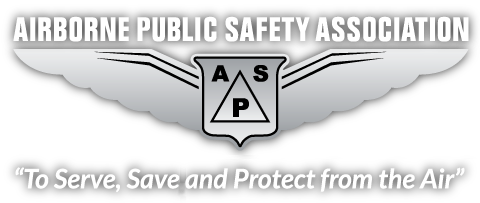
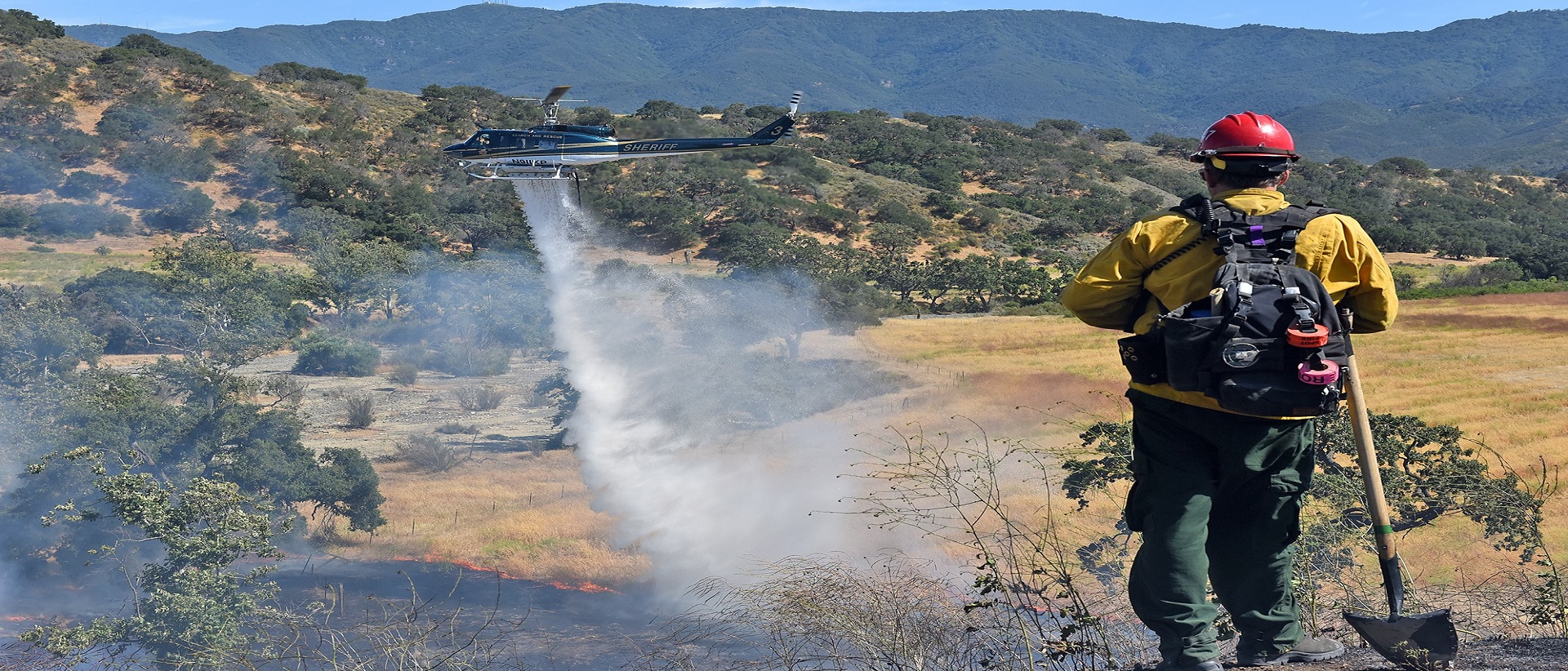

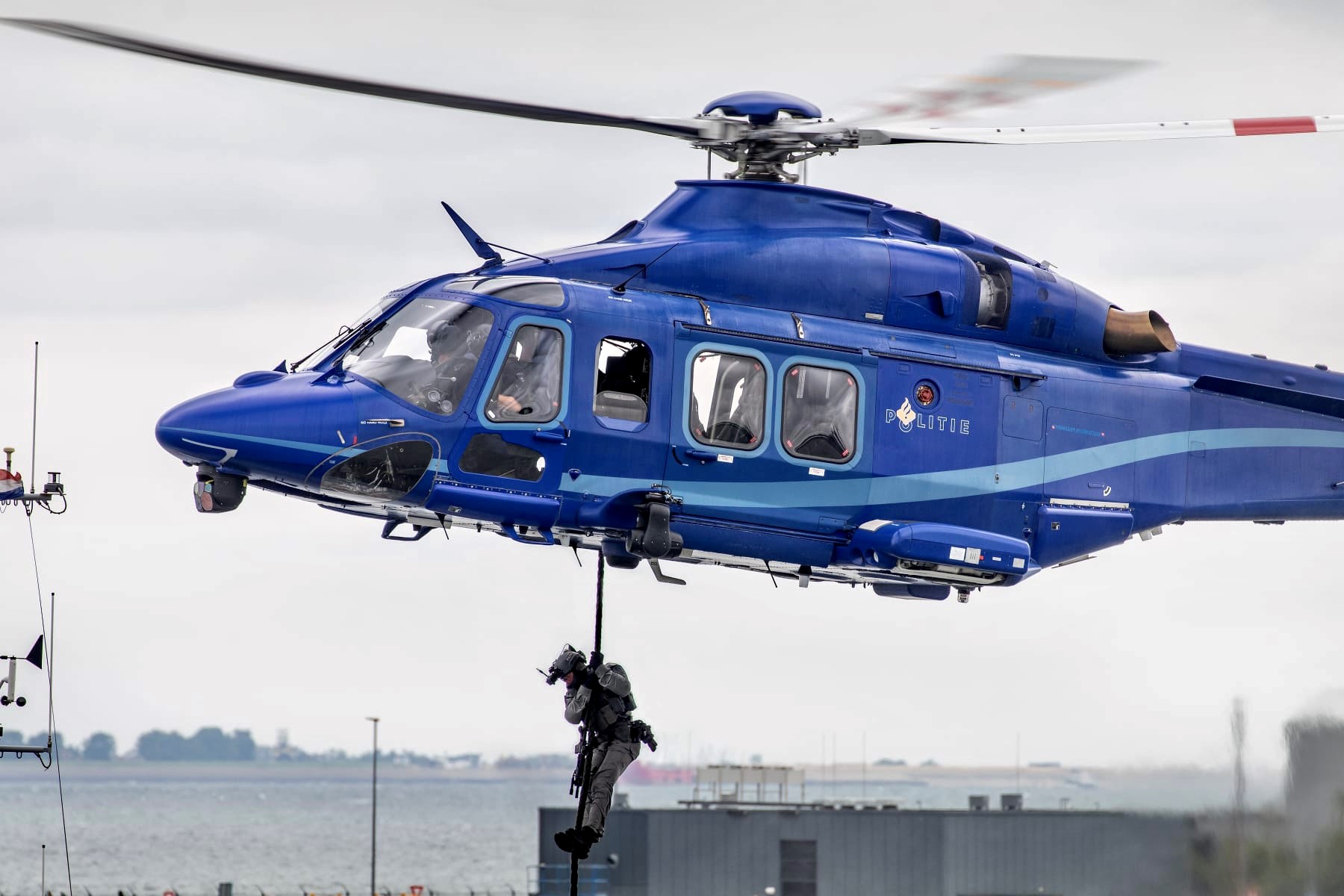
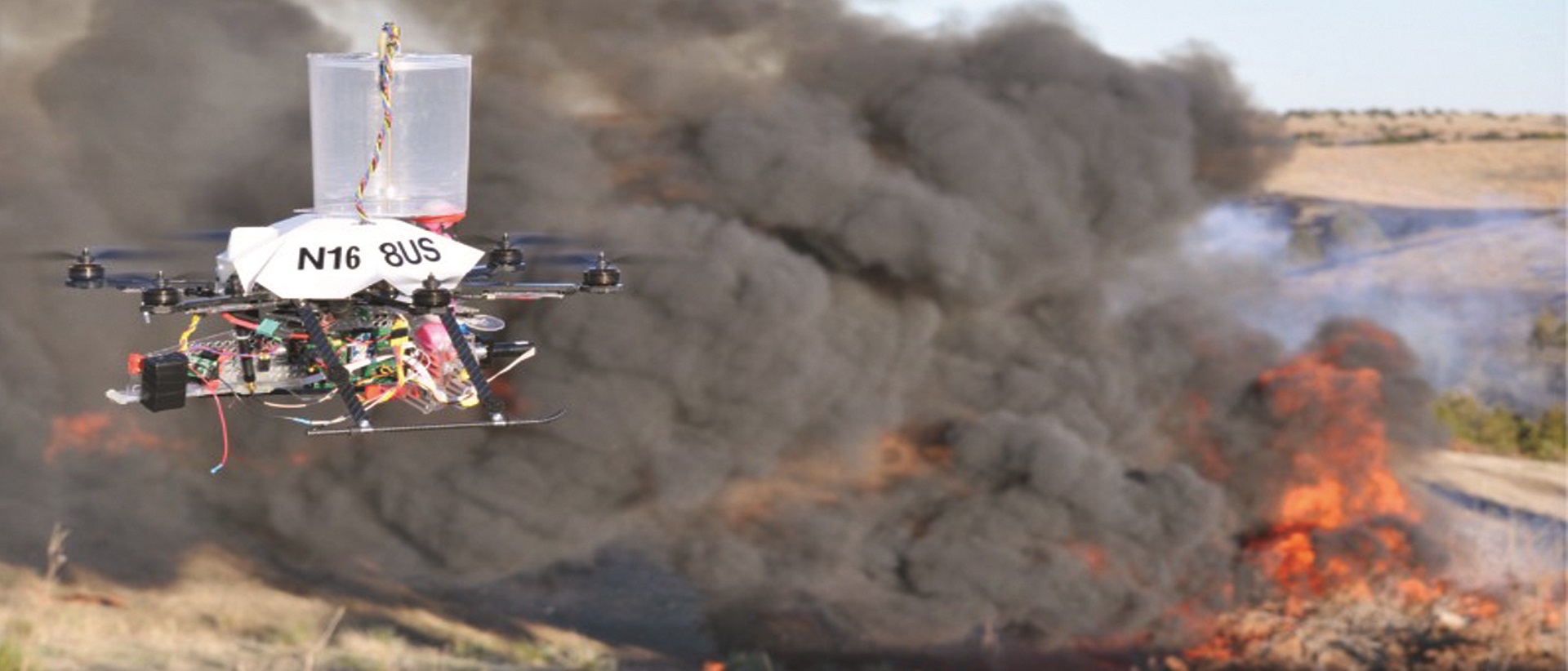
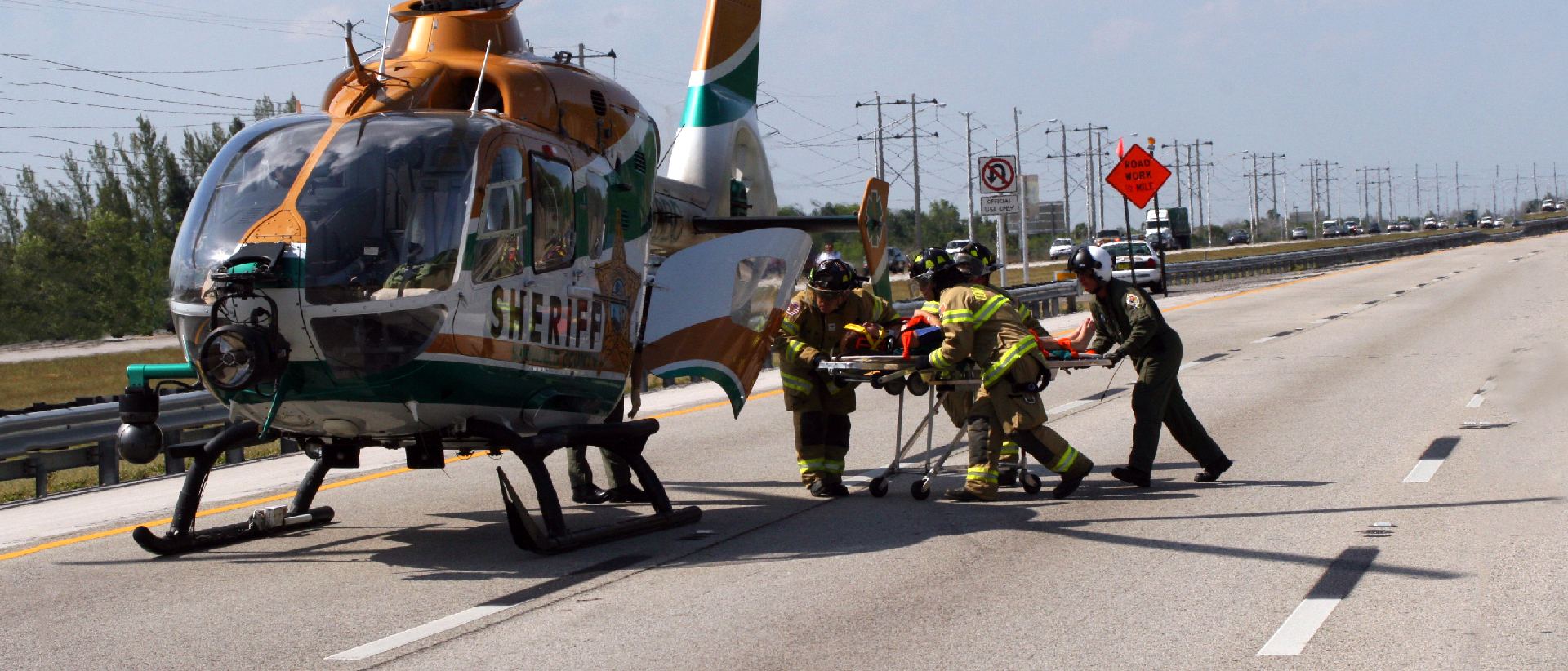
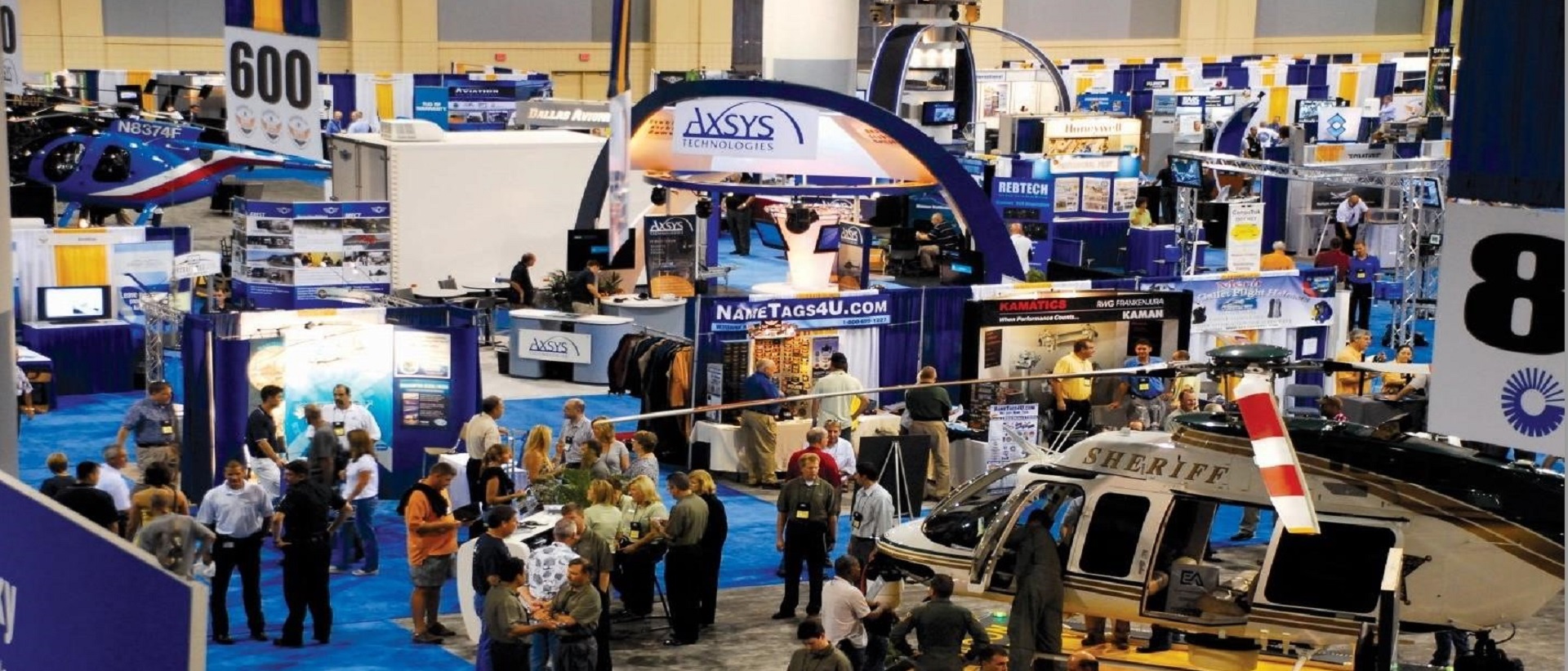
 Three policemen died after their rescue helicopter clipped a mountainside and crashed during a mission in northern Spain on Aug. 24. The accident reportedly occurred after the rescue team dropped a fourth crewmember by winch to an injured mountaineer. The surviving crewmember reported seeing the helicopter's rotor blades brush against the mountainside, causing the aircraft to plunge down a slope.
Three policemen died after their rescue helicopter clipped a mountainside and crashed during a mission in northern Spain on Aug. 24. The accident reportedly occurred after the rescue team dropped a fourth crewmember by winch to an injured mountaineer. The surviving crewmember reported seeing the helicopter's rotor blades brush against the mountainside, causing the aircraft to plunge down a slope. The Federal Aviation Administration issued a temporary flight restriction on Aug. 12 after rioters in Ferguson, MO, fired on a St. Louis Police Metro Air Support Unit helicopter. Ferguson had erupted into sometimes-violent protests after 18-year-old Michael Brown was shot. The stated reason for the flight restriction was to "provide a safe environment for law enforcement activities."
The Federal Aviation Administration issued a temporary flight restriction on Aug. 12 after rioters in Ferguson, MO, fired on a St. Louis Police Metro Air Support Unit helicopter. Ferguson had erupted into sometimes-violent protests after 18-year-old Michael Brown was shot. The stated reason for the flight restriction was to "provide a safe environment for law enforcement activities." The military surplus program, a popular means of obtaining a low cost helicopter for many airborne law enforcement units, has come under increased public scrutiny as images of police outfitted in paramilitary gear have clashed with protesters in suburban St. Louis after the shooting death of Michael Brown.
The military surplus program, a popular means of obtaining a low cost helicopter for many airborne law enforcement units, has come under increased public scrutiny as images of police outfitted in paramilitary gear have clashed with protesters in suburban St. Louis after the shooting death of Michael Brown. FAA announced in early August the unmanned aircraft system test site in Rome, NY, has started operations, making it the fifth of the six announced test sites to start operations. Several days after the announcement, the agency said tests had begun at Virginia Tech University in Blacksburg, VA.
FAA announced in early August the unmanned aircraft system test site in Rome, NY, has started operations, making it the fifth of the six announced test sites to start operations. Several days after the announcement, the agency said tests had begun at Virginia Tech University in Blacksburg, VA.
 The 2014 Night Vision Awards selection committee members presented the Mark of Excellence Award, which recognizes a unit/company that signifies dedication to quality and excellence in their operation, to Air Methods Corporation. The NightCon Lifetime Achievement Award was presented to retired San Diego Police Department Pilot Kevin Means. Both awards were presented at the 2014 NightCon seminar in Dallas, TX, on Aug. 20 in front of more than 100 industry leaders.
The 2014 Night Vision Awards selection committee members presented the Mark of Excellence Award, which recognizes a unit/company that signifies dedication to quality and excellence in their operation, to Air Methods Corporation. The NightCon Lifetime Achievement Award was presented to retired San Diego Police Department Pilot Kevin Means. Both awards were presented at the 2014 NightCon seminar in Dallas, TX, on Aug. 20 in front of more than 100 industry leaders. The Omaha (NE) Police Department Air Support Unit was forced to suspend flights for two weeks starting on Aug. 10 when a routine inspection discovered a problem with one of its Bell 206B JetRangers. "We examined one of the fuel filters in the helicopter and saw some black material that we didn't like," Lieutenant Mike Davis said. As a precaution, he suspended operations.
The Omaha (NE) Police Department Air Support Unit was forced to suspend flights for two weeks starting on Aug. 10 when a routine inspection discovered a problem with one of its Bell 206B JetRangers. "We examined one of the fuel filters in the helicopter and saw some black material that we didn't like," Lieutenant Mike Davis said. As a precaution, he suspended operations.
 The San Jose (CA) Police Department became the first law enforcement agency in its area to acquire an unmanned aircraft system when it purchased a Century NEO 660 V2 hexacopter for $7,000 in January. The purchase was made public in late July, though department officials have not yet indicated full guidelines for the aircraft's use. San Jose police officials said in early August they "should have done a better job of communicating" with the public about their UAS purchase.
The San Jose (CA) Police Department became the first law enforcement agency in its area to acquire an unmanned aircraft system when it purchased a Century NEO 660 V2 hexacopter for $7,000 in January. The purchase was made public in late July, though department officials have not yet indicated full guidelines for the aircraft's use. San Jose police officials said in early August they "should have done a better job of communicating" with the public about their UAS purchase. A 20-year-old man is accused of pointing a laser at a Texas Department of Public Safety (DPS) helicopter and temporarily blinding the pilot. The man allegedly aimed the green laser at the TXDPS chopper on Aug. 13.
A 20-year-old man is accused of pointing a laser at a Texas Department of Public Safety (DPS) helicopter and temporarily blinding the pilot. The man allegedly aimed the green laser at the TXDPS chopper on Aug. 13.
 The Tulsa (OK) Police Department Air Support Unit recently added an Airbus AS350 to its fleet. The aircraft was completed for the law enforcement mission by Metro Aviation in Shreveport, LA, and delivered in early August. The single-engine aircraft is equipped with a locking rifle rack, overhead communication panel with flip down monitor, searchlight and FLIR system. Revue Thommen AG of Switzerland provided the helicopter's searchlight.
The Tulsa (OK) Police Department Air Support Unit recently added an Airbus AS350 to its fleet. The aircraft was completed for the law enforcement mission by Metro Aviation in Shreveport, LA, and delivered in early August. The single-engine aircraft is equipped with a locking rifle rack, overhead communication panel with flip down monitor, searchlight and FLIR system. Revue Thommen AG of Switzerland provided the helicopter's searchlight. A rider who fell from his jet ski in high seas in Dubai was rescued by helicopter after spending more than 15 hours in the water on Aug. 19. The 34-year-old had been out at sea with a fellow rider when his craft flipped over. He climbed onto his companion's jet ski but again fell off. His friend then returned to shore and called emergency services.
A rider who fell from his jet ski in high seas in Dubai was rescued by helicopter after spending more than 15 hours in the water on Aug. 19. The 34-year-old had been out at sea with a fellow rider when his craft flipped over. He climbed onto his companion's jet ski but again fell off. His friend then returned to shore and called emergency services.
 The Maryland State Police has taken delivery of its tenth AW139 to be used for the state's emergency medical, search and rescue, law enforcement and homeland security missions. All 10 of the aircraft ordered have been built and delivered from AgustaWestland's Philadelphia assembly line, which operates out of a 275,000 square foot facility on a 39-acre site at Northeast Philadelphia Airport. The Maryland State Police Aviation Command has already begun to benefit from the expanded capability afforded by the AW139 platform.
The Maryland State Police has taken delivery of its tenth AW139 to be used for the state's emergency medical, search and rescue, law enforcement and homeland security missions. All 10 of the aircraft ordered have been built and delivered from AgustaWestland's Philadelphia assembly line, which operates out of a 275,000 square foot facility on a 39-acre site at Northeast Philadelphia Airport. The Maryland State Police Aviation Command has already begun to benefit from the expanded capability afforded by the AW139 platform. The Spokane County (WA) Sheriff's Office Air Support Unit has acquired two military surplus helicopters to add to its Air 1 program. One of the two OH-58 Kiowas is intended to serve as a backup during Air 1's maintenance downtime; the other is to be used for spare parts.
The Spokane County (WA) Sheriff's Office Air Support Unit has acquired two military surplus helicopters to add to its Air 1 program. One of the two OH-58 Kiowas is intended to serve as a backup during Air 1's maintenance downtime; the other is to be used for spare parts.
 Los Angeles Police Department officials recently announced they may set boundaries on the use of hobbyist unmanned aircraft systems because local ordinances are vague and federal regulators have been slow to act. With FAA regulations in limbo due to recent court rulings, virtually no laws are on the books regulating where everyday hobbyists can fly UAS, and incidents are mounting.
Los Angeles Police Department officials recently announced they may set boundaries on the use of hobbyist unmanned aircraft systems because local ordinances are vague and federal regulators have been slow to act. With FAA regulations in limbo due to recent court rulings, virtually no laws are on the books regulating where everyday hobbyists can fly UAS, and incidents are mounting. A U.K. man was arrested after allegedly shining a laser beam at a Humberside Police helicopter in North East Lincolnshire. Humberside Police officials said they believed the laser had been aimed at the helicopter from a car. A 40-year-old van driver was later traced and arrested in the area.
A U.K. man was arrested after allegedly shining a laser beam at a Humberside Police helicopter in North East Lincolnshire. Humberside Police officials said they believed the laser had been aimed at the helicopter from a car. A 40-year-old van driver was later traced and arrested in the area.
 Did you know that the majority of the photography you enjoy in APSA media such as Air Beat, the APSA Calendar, and our website is provided compliments of our membership? That's right, we rely on the shutterbugs amongst you for that outstanding graphic content. So if you are an aspiring photog looking for an outlet or a seasoned lensman with a philanthropic leaning, we need and appreciate your best shots of public safety aircraft and aircrews in action. With our 2015 APSA Calendar starting production soon, and with images for our new APSA exhibit booth in the final selection stages, there is ample opportunity to have your work represent our industry to our members and the thousands that receive our publications, visit our website, or stop by our booth at trade shows such as HELI-EXPO, IACP, NSA, AUVSI and our own APSA EXPO. Photos can be submitted to
Did you know that the majority of the photography you enjoy in APSA media such as Air Beat, the APSA Calendar, and our website is provided compliments of our membership? That's right, we rely on the shutterbugs amongst you for that outstanding graphic content. So if you are an aspiring photog looking for an outlet or a seasoned lensman with a philanthropic leaning, we need and appreciate your best shots of public safety aircraft and aircrews in action. With our 2015 APSA Calendar starting production soon, and with images for our new APSA exhibit booth in the final selection stages, there is ample opportunity to have your work represent our industry to our members and the thousands that receive our publications, visit our website, or stop by our booth at trade shows such as HELI-EXPO, IACP, NSA, AUVSI and our own APSA EXPO. Photos can be submitted to  Mississippi Highway Patrol AS350 Adds Imaging System
Mississippi Highway Patrol AS350 Adds Imaging System
 New York State Police, with assistance from its Aviation Unit, seized 114 marijuana plants growing in three Allegany County communities in late August and arrested two residents. State troopers were assisted in the marijuana eradication effort the helicopter crews and state forest rangers.
New York State Police, with assistance from its Aviation Unit, seized 114 marijuana plants growing in three Allegany County communities in late August and arrested two residents. State troopers were assisted in the marijuana eradication effort the helicopter crews and state forest rangers. A Maricopa County (AZ) Sheriff's Office helicopter responded to a call on Aug. 19 about a woman trapped inside a vehicle stranded in floodwater. The helicopter reportedly touched down near the woman's minivan, crewmembers got out of the aircraft, and the pilot, Sergeant Wes Kueffer, waded into the muddy water and pulled the woman to safety. Deputy Joe Sudella assisted Kueffer in the effort. Together, the two men were able to walk the woman through the water to dry ground, where she was wrapped in a blanket.
A Maricopa County (AZ) Sheriff's Office helicopter responded to a call on Aug. 19 about a woman trapped inside a vehicle stranded in floodwater. The helicopter reportedly touched down near the woman's minivan, crewmembers got out of the aircraft, and the pilot, Sergeant Wes Kueffer, waded into the muddy water and pulled the woman to safety. Deputy Joe Sudella assisted Kueffer in the effort. Together, the two men were able to walk the woman through the water to dry ground, where she was wrapped in a blanket.
 Individuals
Individuals Corporate
Corporate The time to book travel to Seattle for the Western Region Safety Seminar is now. The event will be held at the Motif Seattle Hotel from Sept. 23 to 25 and hosted by the King County (WA) Sheriff's Office Air Support Unit.
The time to book travel to Seattle for the Western Region Safety Seminar is now. The event will be held at the Motif Seattle Hotel from Sept. 23 to 25 and hosted by the King County (WA) Sheriff's Office Air Support Unit.
